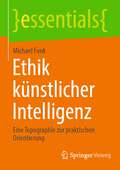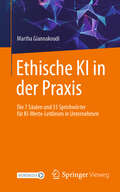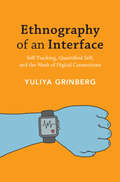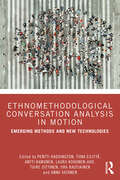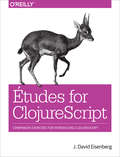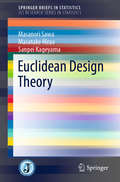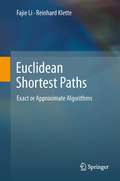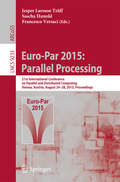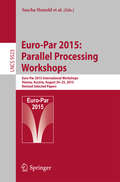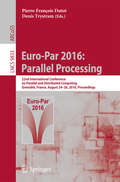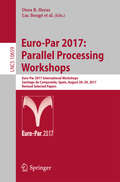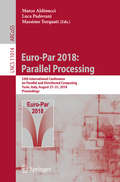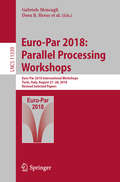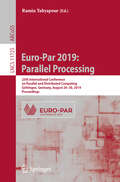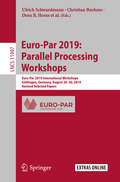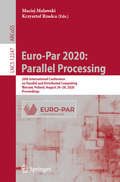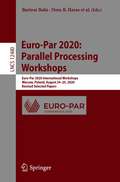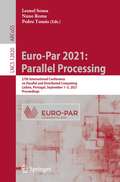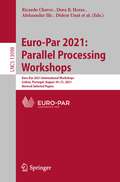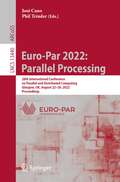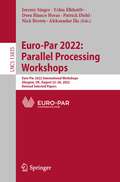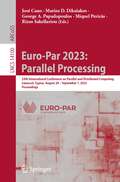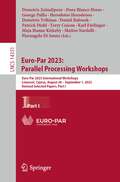- Table View
- List View
Ethik künstlicher Intelligenz: Eine Topographie zur praktischen Orientierung (essentials)
by Michael FunkKünstliche Intelligenz ist zum vielschichtigen Gegenstand ethischer Debatten geworden. Ob Richtlinien fairer Digitalisierung und vertrauenswürdiger Algorithmen, Gestaltung nachhaltiger Geschäftsmodelle, informatische Grundbildung in Schulen oder Existenzfragen freiheitlich-demokratischer Gesellschaften – KI-Ethik steht vor komplexen Herausforderungen. Grundsätzlicher Klärungsbedarf entsteht durch die verschiedenen Zugänge, Interessen und Begrifflichkeiten, die aufeinandertreffen. Vorliegendes essential präsentiert auf zugängliche Weise wissenschaftliches Überblickswissen zur KI-Ethik. Als praktische Orientierungshilfe im komplexen Terrain dient eine thematische Topographie, einschließlich zentraler Begriffe. Zusammenhänge zwischen Industrie 5.0, Regulierung, Post- und Transhumanismus, selbstfahrenden Autos, moralischen Maschinen, nachhaltiger Digitalisierung oder dem Anthropozän werden mit Blick auf KI-Ethik systematisch sichtbar gemacht.
Ethische KI in der Praxis. Die 7 Säulen und 33 Sprichwörter für KI-Werte-Leitlinien in Unternehmen
by Martha GiannakoudiKünstliche Intelligenz ist nicht länger Zukunftsmusik – sie gestaltet bereits heute den Arbeitsalltag. Doch wie lässt sich sicherstellen, dass Teams durch KI nicht nur effizienter, sondern auch hochwertiger, reflektierter und verantwortungsvoller arbeiten? „Ethische KI in der Praxis&“ von Martha Giannakoudi ist der unverzichtbare Kompass in dieser neuen Ära. Das Buch liefert mehr als nur abstrakte Theorien und bietet ein robustes Fundament, das auf 7 entscheidenden Säulen wie Menschenzentriertheit, Qualität, Ethik, Datenschutz und Transparenz aufbaut. Das Herzstück sind jedoch 33 kraftvolle Sprichwörter. Sie übersetzen komplexe Wertefragen in eingängige Bilder und machen Ethik im Alltag lebendig und anwendbar. Der Ansatz des Buches befähigt Teams und Führungskräfte, eine Kultur zu schaffen, in der menschliche Intelligenz nicht verkümmert, sondern durch den bewussten Einsatz von KI wächst, die Arbeitsqualität nachhaltig steigt und das entscheidende Vertrauen in die neue Zusammenarbeit gesichert wird. Praxisnahe Interviews mit führenden Expert*innen aus Wirtschaft, Wissenschaft, Verwaltung, Kunst und Religion schlagen gemeinsam mit der fundierten Erfahrung der Autorin die entscheidende Brücke von der Debatte zur erfolgreichen Umsetzung. Ein Wegweiser für alle, die KI-Systeme nicht nur implementieren, sondern meistern wollen.
Ethnography of an Interface: Self-Tracking, Quantified Self, and the Work of Digital Connections
by Yuliya GrinbergTechnologists frequently promote self-tracking devices as objective tools. This book argues that such glib and often worrying assertions must be placed in the context of precarious industry dynamics. The author draws on several years of ethnographic fieldwork with developers of self-tracking applications and wearable devices in New York City's Silicon Alley and with technologists who participate in the international forum called the Quantified Self to illuminate the professional compromises that shape digital technology and the gap between the tech sector's public claims and its interior processes. By reconciling the business conventions, compromises, shifting labor practices, and growing employment insecurity that power the self-tracking market with device makers' often simplistic promotional claims, the book offers an understanding of the impact that technologists exert on digital discourse, on the tools they make, and on the data that these gadgets put out into the world.
Ethnomethodological Conversation Analysis in Motion: Emerging Methods and New Technologies
by Pentti Haddington, Tiina Eilittä, Antti Kamunen, Laura Kohonen-Aho, Tuire Oittinen, Iira Rautiainen and Anna VatanenThis volume discusses current and emerging trends in Ethnomethodological Conversation Analysis (EMCA). Focusing on step-by-step procedures of talk and interaction in real time, EMCA explores how people – through locally-produced, public, and common-sensical practices – accomplish activities together and thereby make sense and create social order as part of their everyday lives. The volume is divided into four parts, and it provides a timely methodological contribution by exploring new questions, settings, and recording technologies in EMCA for the study of social interaction. It addresses the methodical diversity in EMCA, including current practices as well as those testing its boundaries, and paves way for the development of future interaction research. At the same time, the book offers readers a glimpse into the ways in which human and non-human participants operate with each other and make sense of the world around them. The authors represent diverse fields of research, such as language studies, sociology, social psychology, human-computer interaction, and cognitive science. Ultimately, the book is a conversation opener that invites critical and constructive dialogue on how EMCA’s methodology and toolbox could be developed for the purpose of acquiring richer perspectives on endogenous social action. This is key reading for researchers and advanced students on a range of courses on conversation analysis, language in interaction, discourse studies, multimodality and more.
Etsy Excellence: The Simple Guide to Creating a Thriving Etsy Business
by Tycho PressThe Ambitious Crafter's Guide to a Profitable Etsy ShopMore than a marketplace, Etsy is a community—and being an active, informed member can lead to lucrative results. This book provides actionable steps to help shop owners engage the Etsy community in authentic ways that attract buyers and generate sales.The best Etsy shops stand out among the sea of sellers and a draw loyal customer base, but how they've done it isn't—and shouldn't be—a secret. In these pages, top Etsy sellers share the tools that have helped them, the changes they made that yielded positive results, and their best advice for achieving and sustaining a successful Etsy shop.Beyond sellers' words of wisdom, this book offers a roadmap all Etsy sellers can follow in order to:- Choose keywords and tags to drive traffic to your Etsy shop - Photograph your products for maximum appeal - Create a unique Etsy shop that stands out - Write winning product descriptions - Price your goods appropriately - Market your products effectively on social media platforms - Maintain lasting relationships with your Etsy customers - Diversify your Etsy product offerings
Etudes for ClojureScript
by J. David EisenbergA short composition that provides practice material for a particular musical skill is called an étude. In this hands-on book, you’ll find more than 30 études to help you practice ClojureScript skills for specific programming areas, ranging from functions and variables to asynchronous processing. Each of these small projects includes a description of a program that you will compose (write) in ClojureScript.Though not as difficult as their musical counterparts, these programming études will help you stretch beyond the material and examples that you find in most ClojureScript books or online references. One chapter features études for an open-ended project that will help you put together what you’ve learned. Solutions to each étude are revealed in the appendix.Programming areas include:Working with functions and variables with def and letInteracting with JavaScript and web pages, using several librariesLists, vectors, and higher-order map, filter, and reduce functionsData mapping with ClojureScriptUsing different ClojureScript libraries to program with ReactAdding, subtracting, multiplying, and dividing rational and complex numbers with defprotocol and defrecordAsynchronous processing with core.async
Euclidean Design Theory (SpringerBriefs in Statistics)
by Masanori Sawa Masatake Hirao Sanpei KageyamaThis book is the modern first treatment of experimental designs, providing a comprehensive introduction to the interrelationship between the theory of optimal designs and the theory of cubature formulas in numerical analysis. It also offers original new ideas for constructing optimal designs. The book opens with some basics on reproducing kernels, and builds up to more advanced topics, including bounds for the number of cubature formula points, equivalence theorems for statistical optimalities, and the Sobolev Theorem for the cubature formula. It concludes with a functional analytic generalization of the above classical results. Although it is intended for readers who are interested in recent advances in the construction theory of optimal experimental designs, the book is also useful for researchers seeking rich interactions between optimal experimental designs and various mathematical subjects such as spherical designs in combinatorics and cubature formulas in numerical analysis, both closely related to embeddings of classical finite-dimensional Banach spaces in functional analysis and Hilbert identities in elementary number theory. Moreover, it provides a novel communication platform for “design theorists” in a wide variety of research fields.
Euclidean Shortest Paths
by Fajie Li Reinhard KletteThis unique text/reference reviews algorithms for the exact or approximate solution of shortest-path problems, with a specific focus on a class of algorithms called rubberband algorithms. Discussing each concept and algorithm in depth, the book includes mathematical proofs for many of the given statements. Topics and features: provides theoretical and programming exercises at the end of each chapter; presents a thorough introduction to shortest paths in Euclidean geometry, and the class of algorithms called rubberband algorithms; discusses algorithms for calculating exact or approximate ESPs in the plane; examines the shortest paths on 3D surfaces, in simple polyhedrons and in cube-curves; describes the application of rubberband algorithms for solving art gallery problems, including the safari, zookeeper, watchman, and touring polygons route problems; includes lists of symbols and abbreviations, in addition to other appendices.
Euro-Par 2015: Parallel Processing
by Sascha Hunold Jesper Larsson Träff Francesco VersaciThis book constitutes the refereed proceedings of the 21st International Conference on Parallel and Distributed Computing, Euro-Par 2015, held in Vienna, Austria, in August 2015. The 51 revised full papers presented together with 2 invited papers were carefully reviewed and selected from 190 submissions. The papers are organized in the following topical sections: support tools and environments; performance modeling, prediction and evaluation; scheduling and load balancing; architecture and compilers; parallel and distributed data management; grid, cluster and cloud computing; distributed systems and algorithms; parallel and distributed programming, interfaces and languages; multi- and many-core programming; theory and algorithms for parallel computation; numerical methods and applications; and accelerator computing.
Euro-Par 2015: Parallel Processing Workshops
by Michael Alexander Sascha Hunold Alexandru Costan Domingo Giménez Alexandru Iosup Laura Ricci María Engracia Gómez Requena Vittorio Scarano Ana Lucia Varbanescu Stephen L. Scott Stefan Lankes Josef WeidendorferThis book constitutes the thoroughly refereedpost-conference proceedings of 12 workshops held at the 21st InternationalConference on Parallel and Distributed Computing, Euro-Par 2015, in Vienna,Austria, in August 2015. The 67 revised full papers presented were carefully reviewedand selected from 121 submissions. The volume includes papers from thefollowing workshops: BigDataCloud: 4th Workshop on Big Data Management inClouds - Euro-EDUPAR: First European Workshop on Parallel and DistributedComputing Education for Undergraduate Students - Hetero Par: 13th InternationalWorkshop on Algorithms, Models and Tools for Parallel Computing onHeterogeneous Platforms - LSDVE: Third Workshop on Large Scale DistributedVirtual Environments - OMHI: 4th International Workshop on On-chip MemoryHierarchies and Interconnects - PADAPS: Third Workshop on Parallel andDistributed Agent-Based Simulations - PELGA: Workshop on PerformanceEngineering for Large-Scale Graph Analytics - REPPAR: Second InternationalWorkshop on Reproducibility in Parallel Computing - Resilience: 8th Workshop onResiliency in High Performance Computing in Clusters, Clouds, and Grids - ROME:Third Workshop on Runtime and Operating Systems for the Many Core Era - UCHPC:8th Workshop on UnConventional High Performance Computing - and VHPC: 10thWorkshop on Virtualization in High-Performance Cloud Computing.
Euro-Par 2016: Parallel Processing
by Pierre-François Dutot Denis TrystramThis book constitutes the refereed proceedings of the 22nd International Conference on Parallel and Distributed Computing, Euro-Par 2016, held in Grenoble, France, in August 2016. The 47 revised full papers presented together with 2 invited papers and one industrial paper were carefully reviewed and selected from 176 submissions. The papers are organized in 12 topical sections: Support Tools and Environments; Performance and Power Modeling, Prediction and Evaluation; Scheduling and Load Balancing; High Performance Architectures and Compilers; Parallel and Distributed Data Management and Analytics; Cluster and Cloud Computing; Distributed Systems and Algorithms; Parallel and Distributed Programming, Interfaces, Languages; Multicore and Manycore Parallelism; Theory and Algorithms for Parallel Computation and Networking; Parallel Numerical Methods and Applications; Accelerator Computing.
Euro-Par 2017: Euro-par 2017 International Workshops, Santiago De Compostela, Spain, August 28-29, 2017, Revised Selected Papers (Lecture Notes in Computer Science #10659)
by Luc Bougé Dora B. HerasThis book constitutes the proceedings of the workshops of the 23rd International Conference on Parallel and Distributed Computing, Euro-Par 2017, held in Santiago de Compostela. Spain in August 2017. The 59 full papers presented were carefully reviewed and selected from 119 submissions.Euro-Par is an annual, international conference in Europe, covering all aspects of parallel and distributed processing. These range from theory to practice, from small to the largest parallel and distributed systems and infrastructures, from fundamental computational problems to full-edged applications, from architecture, compiler, language and interface design and implementation to tools, support infrastructures, and application performance aspects.
Euro-Par 2018: 24th International Conference on Parallel and Distributed Computing, Turin, Italy, August 27 - 31, 2018, Proceedings (Lecture Notes in Computer Science #11014)
by Massimo Torquati Marco Aldinucci Luca PadovaniThis book constitutes the proceedings of the 24th International Conference on Parallel and Distributed Computing, Euro-Par 2018, held in Turin, Italy, in August 2018. The 57 full papers presented in this volume were carefully reviewed and selected from 194 submissions. They were organized in topical sections named: support tools and environments; performance and power modeling, prediction and evaluation; scheduling and load balancing; high performance architecutres and compilers; parallel and distributed data management and analytics; cluster and cloud computing; distributed systems and algorithms; parallel and distributed programming, interfaces, and languages; multicore and manycore methods and tools; theory and algorithms for parallel computation and networking; parallel numerical methods and applications; and accelerator computing for advanced applications.
Euro-Par 2018: Parallel Processing Workshops (Lecture Notes in Computer Science #11339)
by Emmanuel Jeannot Laura Ricci Stephen L. Scott Dora B. Heras Gabriele Mencagli Valeria Cardellini Emiliano Casalicchio Felix Wolf Antonio Salis Claudio Schifanella Ravi Reddy Manumachu Marco Beccuti Laura Antonelli José Daniel Garcia SanchezThis book constitutes revised selected papers from of the workshops held at 24th International Conference on Parallel and Distributed Computing, Euro-Par 2018, which took place in Turin, Italy, in August 2018. The 64 full papers presented in this volume were carefully reviewed and selected from 109 submissions.Euro-Par is an annual, international conference in Europe, covering all aspects of parallel and distributed processing. These range from theory to practice, from small to the largest parallel and distributed systems and infrastructures, from fundamental computational problems to full-edged applications, from architecture, compiler, language and interface design and implementation to tools, support infrastructures, and application performance aspects. Brand: Springer.
Euro-Par 2019: 25th International Conference on Parallel and Distributed Computing, Göttingen, Germany, August 26–30, 2019, Proceedings (Lecture Notes in Computer Science #11725)
by Ramin YahyapourThis book constitutes the proceedings of the 25th International Conference on Parallel and Distributed Computing, Euro-Par 2019, held in Göttingen, Germany, in August 2019. The 36 full papers presented in this volume were carefully reviewed and selected from 142 submissions. They deal with parallel and distributed computing in general, focusing on support tools and environments; performance and power modeling, prediction and evaluation; scheduling and load balancing; high performance architectures and compilers; data management, analytics and deep learning; cluster and cloud computing; distributed systems and algorithms; parallel and distributed programming, interfaces, and languages; multicore and manycore parallelism; theory and algorithms for parallel computation and networking; parallel numerical methods and applications; accelerator computing; algorithms and systems for bioinformatics; and algorithms and systems for digital humanities.
Euro-Par 2019: Euro-Par 2019 International Workshops, Göttingen, Germany, August 26–30, 2019, Revised Selected Papers (Lecture Notes in Computer Science #11997)
by Thomas Gruber Emmanuel Jeannot Laura Ricci Stephen L. Scott Dieter Schwamborn Dora B. Heras Valeria Cardellini Antonio Salis Claudio Schifanella Ravi Reddy Manumachu Laura Antonelli Ulrich Schwardmann Christian Boehme Oh SangyoonThis book constitutes revised selected papers from the workshops held at 25th International Conference on Parallel and Distributed Computing, Euro-Par 2019, which took place in Göttingen, Germany, in August 2019. The 53 full papers and 10 poster papers presented in this volume were carefully reviewed and selected from 77 submissions. Euro-Par is an annual, international conference in Europe, covering all aspects of parallel and distributed processing. These range from theory to practice, from small to the largest parallel and distributed systems and infrastructures, from fundamental computational problems to full-edged applications, from architecture, compiler, language and interface design and implementation to tools, support infrastructures, and application performance aspects. Chapter "In Situ Visualization of Performance-Related Data in Parallel CFD Applications" is available open access under a Creative Commons Attribution 4.0 International License via link.springer.com.
Euro-Par 2020: 26th International Conference on Parallel and Distributed Computing, Warsaw, Poland, August 24–28, 2020, Proceedings (Lecture Notes in Computer Science #12247)
by Maciej Malawski Krzysztof RzadcaThis book constitutes the proceedings of the 26th International Conference on Parallel and Distributed Computing, Euro-Par 2020, held in Warsaw, Poland, in August 2020. The conference was held virtually due to the coronavirus pandemic. The 39 full papers presented in this volume were carefully reviewed and selected from 158 submissions. They deal with parallel and distributed computing in general, focusing on support tools and environments; performance and power modeling, prediction and evaluation; scheduling and load balancing; high performance architectures and compilers; data management, analytics and machine learning; cluster, cloud and edge computing; theory and algorithms for parallel and distributed processing; parallel and distributed programming, interfaces, and languages; multicore and manycore parallelism; parallel numerical methods and applications; and accelerator computing.
Euro-Par 2020: Euro-Par 2020 International Workshops, Warsaw, Poland, August 24–25, 2020, Revised Selected Papers (Lecture Notes in Computer Science #12480)
by Thomas Gruber Michael Kuhn Roman Wyrzykowski Stephen L. Scott Andrea Bracciali Dora B. Heras Laura Antonelli Bartosz Balis Jin Hyun-Wook Didem UnatThis book constitutes revised selected papers from the workshops held at the 26th International Conference on Parallel and Distributed Computing, Euro-Par 2020, which took place in Warsaw, Poland, in August 2020. The workshops were held virtually due to the coronavirus pandemic.The 27 full papers presented in this volume were carefully reviewed and selected from 50 submissions. Euro-Par is an annual, international conference in Europe, covering all aspects of parallel and distributed processing. These range from theory to practice, from small to the largest parallel and distributed systems and infrastructures, from fundamental computational problems to full-edged applications, from architecture, compiler, language and interface design and implementation to tools, support infrastructures, and application performance aspects.
Euro-Par 2021: 27th International Conference on Parallel and Distributed Computing, Lisbon, Portugal, September 1–3, 2021, Proceedings (Lecture Notes in Computer Science #12820)
by Leonel Sousa Nuno Roma Pedro TomásThis book constitutes the proceedings of the 27th International Conference on Parallel and Distributed Computing, Euro-Par 2021, held in Lisbon, Portugal, in August 2021. The conference was held virtually due to the COVID-19 pandemic. The 38 full papers presented in this volume were carefully reviewed and selected from 136 submissions. They deal with parallel and distributed computing in general, focusing on compilers, tools and environments; performance and power modeling, prediction and evaluation; scheduling and load balancing; data management, analytics and machine learning; cluster, cloud and edge computing; theory and algorithms for parallel and distributed processing; parallel and distributed programming, interfaces, and languages; parallel numerical methods and applications; and high performance architecture and accelerators.
Euro-Par 2021: Euro-Par 2021 International Workshops, Lisbon, Portugal, August 30-31, 2021, Revised Selected Papers (Lecture Notes in Computer Science #13098)
by Laura Ricci Stephen L. Scott Ricardo Chaves Andrea Bracciali Dora B. Heras Rosa M. Badia Oh Sangyoon Didem Unat Aleksandar Ilic Patrick Diehl Anshu DubeyThis book constitutes revised selected papers from the workshops held at the 27th International Conference on Parallel and Distributed Computing, Euro-Par 2021, which took place in Portugal, in August 2021. The workshops were held virtually due to the coronavirus pandemic.The 39 full papers presented in this volume were carefully reviewed and selected from numerous submissions. The papers cover all aspects of parallel and distributed processing. These range from theory to practice, from small to the largest parallel and distributed systems and infrastructures, from fundamental computational problems to full-edged applications, from architecture, compiler, language and interface design and implementation to tools, support infrastructures, and application performance aspects.
Euro-Par 2022: 28th International Conference on Parallel and Distributed Computing, Glasgow, UK, August 22–26, 2022, Proceedings (Lecture Notes in Computer Science #13440)
by Phil Trinder José CanoThis book constitutes the proceedings of the 33rd International Conference on Parallel and Distributed Computing, Euro-Par 2022, held in Vienna, Austria, in August 2022.The 25 full papers presented in this volume were carefully reviewed and selected from 102 submissions. The conference Euro-Par 2022 covers all aspects of parallel and distributed computing, ranging from theory to practice, scaling from the smallest to the largest parallel and distributed systems, from fundamental computational problems and models to full-fledged applications, from architecture and interface design and implementation to tools, infrastructures and applications.
Euro-Par 2022: Euro-Par 2022 International Workshops, Glasgow, UK, August 22–26, 2022, Revised Selected Papers (Lecture Notes in Computer Science #13835)
by Nick Brown Aleksandar Ilic Patrick Diehl Jeremy Singer Yehia Elkhatib Dora Blanco HerasThis book constitutes revised selected papers from the workshops held at the 28th International European Conference on Parallel and Distributed Computing, Euro-Par 2022, which took place in Glasgow, UK, in August 22–26, 2022Out of a total of 35 submissions 24 papers have been accepted, 19 of these are included in this book.They stem from the following workshops:- Workshop on Algorithms, Models and Tools for Parallel Computing on Heterogeneous Platforms (HeteroPar)- Workshop on Asynchronous Many-Task systems for Exascale (AMTE) - Workshop on Domain Specific Languages for High-Performance Computing (DSL-HPC)- Workshop on Distributed and Heterogeneous Programming in C and C++ (DHPCC++)- Workshop on Resiliency in High Performance Computing in Clouds, Grids, and Clusters (Resilience)In addition, the proceedings also contains 6 extended abstracts from the PhD Symposium.
Euro-Par 2023: 29th International Conference on Parallel and Distributed Computing, Limassol, Cyprus, August 28 – September 1, 2023, Proceedings (Lecture Notes in Computer Science #14100)
by George A. Papadopoulos Rizos Sakellariou Marios D. Dikaiakos José Cano Miquel PericàsThis book constitutes the proceedings of the 34th International Conference on Parallel and Distributed Computing, Euro-Par 2023, held in Limassol, Cyprus, in August/September 2023. The 49 full papers presented in this volume were carefully reviewed and selected from 164 submissions. They are covering the following topics: programming, compilers and performance; scheduling, resource management, cloud, edge computing, and workflows; architectures and accelerators; data analytics, AI, and computational science; theory and algorithms; multidisciplinary, and domain-specific and applied parallel and distributed computing.
Euro-Par 2023: Euro-Par 2023 International Workshops, Limassol, Cyprus, August 28 – September 1, 2023, Revised Selected Papers, Part I (Lecture Notes in Computer Science #14351)
by Karl Fürlinger George Pallis Herodotos Herodotou Patrick Diehl Dora Blanco Heras Demetris Zeinalipour Demetris Trihinas Daniel Balouek Terry Cojean Maja Hanne Kirkeby Matteo Nardelli Pierangelo Di SanzoThis book constitutes revised selected papers from the workshops held at the 29th International Conference on Parallel and Distributed Computing, Euro-Par 2023, which took place in Limassol, Cyprus, during August 28–September 1, 2023. The 42 full papers presented in this book together with 11 symposium papers and 14 demo/poster papers were carefully reviewed and selected from 55 submissions. The papers cover covering all aspects of parallel and distributed processing, ranging from theory to practice, from small to the largest parallel and distributed systems and infrastructures, from fundamental computational problems to applications, from architecture, compiler, language and interface design and implementation, to tools, support infrastructures, and application performance aspects.LNCS 14351:First International Workshop on Scalable Compute Continuum (WSCC 2023). First International Workshop on Tools for Data Locality, Power and Performance (TDLPP 2023). First International Workshop on Urgent Analytics for Distributed Computing (QuickPar 2023). 21st International Workshop on Algorithms, Models and Tools for Parallel Computing on Heterogeneous Platforms (HETEROPAR 2023). LNCS 14352: Second International Workshop on Resource AWareness of Systems and Society (RAW 2023). Third International Workshop on Asynchronous Many-Task systems for Exascale (AMTE 2023). Third International Workshop on Performance and Energy-efficiency in Concurrent and Distributed Systems (PECS 2023) First Minisymposium on Applications and Benefits of UPMEM commercial Massively Parallel Processing-In-Memory Platform (ABUMPIMP 2023). First Minsymposium on Adaptive High Performance Input / Output Systems (ADAPIO 2023).
Euro-Par 2023: Euro-Par 2023 International Workshops, Limassol, Cyprus, August 28 – September 1, 2023, Revised Selected Papers, Part II (Lecture Notes in Computer Science #14352)
by Karl Fürlinger George Pallis Herodotos Herodotou Patrick Diehl Dora Blanco Heras Demetris Zeinalipour Demetris Trihinas Daniel Balouek Terry Cojean Maja Hanne Kirkeby Matteo Nardelli Pierangelo Di SanzoThis book constitutes revised selected papers from the workshops held at the 29th International Conference on Parallel and Distributed Computing, Euro-Par 2023, which took place in Limassol, Cyprus, during August 28–September 1, 2023. The 42 full papers presented in this book together with 11 symposium papers and 14 demo/poster papers were carefully reviewed and selected from 55 submissions. The papers cover covering all aspects of parallel and distributed processing, ranging from theory to practice, from small to the largest parallel and distributed systems and infrastructures, from fundamental computational problems to applications, from architecture, compiler, language and interface design and implementation, to tools, support infrastructures, and application performance aspects. LNCS 14351: First International Workshop on Scalable Compute Continuum (WSCC 2023). First International Workshop on Tools for Data Locality, Power and Performance (TDLPP 2023). First International Workshop on Urgent Analytics for Distributed Computing (QuickPar 2023). 21st International Workshop on Algorithms, Models and Tools for Parallel Computing on Heterogeneous Platforms (HETEROPAR 2023). LNCS 14352: Second International Workshop on Resource AWareness of Systems and Society (RAW 2023). Third International Workshop on Asynchronous Many-Task systems for Exascale (AMTE 2023). Third International Workshop on Performance and Energy-efficiency in Concurrent and Distributed Systems (PECS 2023) First Minisymposium on Applications and Benefits of UPMEM commercial Massively Parallel Processing-In-Memory Platform (ABUMPIMP 2023). First Minsymposium on Adaptive High Performance Input / Output Systems (ADAPIO 2023).
